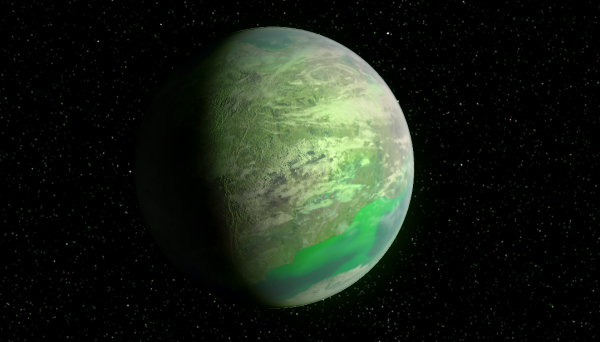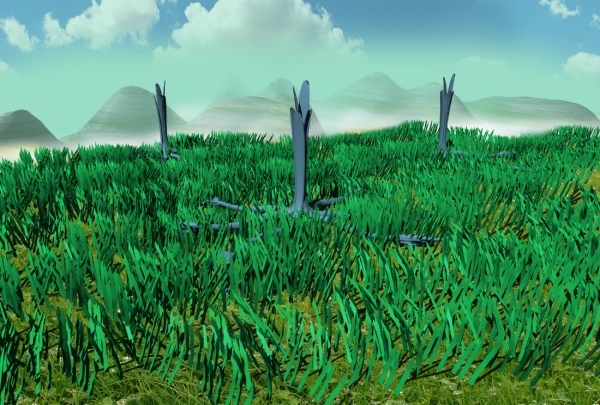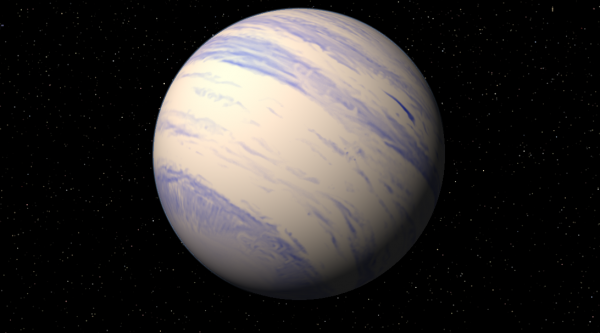BY LETTER
Braciola
Galactography > Regions of Space > Middle Regions/Hinter-regions
Galactography > Systems and Worlds > Systems & Worlds A - B
Galactography > Sephirotic Empires > Zoeific Biopolity
Galactography > Systems and Worlds > Systems & Worlds A - B
Galactography > Sephirotic Empires > Zoeific Biopolity
Middle Regions world with a unique Ecological Consciousness | |
 Image from Steve Bowers | |
| Braciola has 30% ocean cover, with oceans at the poles and a small south polar continent. Most of the surface of this planet, including the oceans and landmasses, is covered with the green tint of the Ecological Consciousness | |
Star: TYC 1100-597-1
Distance from Sol: 177 ly
Constellation: Delphinus
Right ascension: 20h38m16.52s
Declination: +14°44'49.9"
Overview
The Ecological Consciousness of Maiale c (Braciola) is a system of plants that function as neurons, forming a sentient mind. This is done through the plant's ability to absorb the copper from the soil. This allows the plants to send each other electrical impulses, similar to how a neuron functions. The Consciousness is generally classified as a modosophont-level Envome by sophontologists, although it is an unusual example, having emerged spontaneously.History
In the year 2723 AT a colony mission consisting of near-baseline humans arrived at Braciola (Maiale c) and built their colony. They immediately built factories and started a greenhouse effect that put more Co2 into the atmosphere, this both gave the planet a thicker atmosphere and warmed the planet. During this same time, excess oxygen being produced was being let out into the air to help with the terraforming effort. After about one hundred years, the atmosphere was thick enough to support simple plant life such as mosses and lichens. After thirty more years, more dynamic plants, such as bushes and trees could successfully grow outside of the habs. All of which were genetically enhanced to mature and reproduce at nearly four times normal speed. This led to much faster evolution so the plants can better adapt to their environment and produce more food and oxygen. A few years later, small animals were introduced such as earthworms and squirrels.Due to the high copper content in the soil, some of the plants in this ecosystem were designed with insulated copper data connections, resistant to attack by microbes and small animals living underground. These data connections allowed information feedback throughout the artificial ecosphere, using semisentient processors and machine learning to stabilise the environment. Over time this 'smart' ecology became increasingly sophisticated and responsive.
After more than a thousand years of self-improvement the connected ecosphere on this world developed a basic consciousness. At first this was only able to do simple things such as changing leaf size or make roots grow either deeper or wider, in order to adapt to changes in the environment. By the year 4200 AT this emergent 'mind', which became known as the Ecological Consciousness, became sentient and developed complex thoughts. It spanned the planetary surface, including the the oceans.
Eventually, around the year 4972 AT, the Consciousness became smart enough to realize that the towns and cities built by the human colonists were expanding and gradually destroying the local plant life, and decided that this was harmful. The Consciousness decided to stop their expansion by surrounding the colony with dense forest. While this would have been a simple nuisance to the colony, the Braciolan biologists became aware of the strange plant behavior and stopped expanding to study it. They noticed that the plants had a way of communicating with each other. They didn't realize that this was a separate entity until several years later in the year 4983 AT. After this, they stopped expanding and made sure that their farms always had the same number of plants at any one time.
Some historians have questioned whether the Ecological Consciousness was designed deliberately in order to develop sentience, possibly by Pan-sophontist activists among the Braciolan biologists; but no evidence of this has yet been found.
Capabilities: Due to the facts that each plant is functionally a neuron and that there are trillions of plants surrounding the planet, the Ecological Consciousness is one of the smartest modosophont entities in the universe. It is able to decide when and where to grow different plants. It can also move and break large objects such as boulders and small hills using tentacle-like vines and other useful plants. This means that it can effectively change the landscape to coincide with its wishes.
 Image from Steve Bowers | |
| A grassland biome in the Ecological Consciousness. Blue-green information nodes can be seen at regular intervals, coloured by copper compounds. | |
The main goal of this entity is to expand. This is because the more it can expand, the more intelligent it becomes. It can do this by making its plants smaller and more compact, due to this most of the planet has become grassland. Another, more innovative, way of growing is to expand upward. This is done through the use of large trees with pockets of dirt going up the side of the tree filled with smaller plants. So far this entity has shown no desire to leave the planet of its birth, since it does not wish to isolate any part of its mind from any other. Perhaps for this reason it has never shown any tendency to ascend to a higher toposophic level. Since the CompEmp period a delegation from the Zoeific Biopolity has been present on this world, communicating with the Consciousness in its fashion and mediating between this entity and the local human population.
The Maialan System
The Star (Maiale): The star Maiale is a K4V main sequence star with a radius of about 525,000 kilometers. There is nothing particularly notable about this star, it is expected to follow a normal life cycle and go into a planetary nebula when it dies. Although it was discovered many years before 1 AT, it was thoroughly studied by Italian scientists in the year 114 AT. This was when it was discovered that its planets were discovered, including one, Maiale c (Braciola), that looked promising for a colony.Maiale a (Patata): This planet is a small and rocky Hermian type world with practically no volatiles. It has often been compared to Mercury of the Sol system. It got its name, Patata (the Italian word for Potato), as a joke when a scientist said it looked like a potato. This was because of its nearly uniform brown surface with several large craters.
Maiale b (Diviso): This planet has an unusually elliptical orbit, barely within the classification for a planet. This means that for two of its seasons this world has liquid water on its surface and for the other two, the water is evaporated into thick clouds. Although, this cannot be seen through a telescope due to the various other clouds surrounding the planet.
The changing atmospheric composition means that the planet changes colors slightly during different times of the year. This makes the planet look red/orange for half the year and almost pink for the other half. This is because water makes white clouds that add to the natural red/orange when all the water on the planet is in cloud form.
Maiale c (Braciola): This planet was the ideal planet for a human colony. When humans first settled there. It was mostly flat with only a few mountains. There was already a small amount of oxygen and nitrogen in the atmosphere, although not enough to support life. This planet also has many lakes and ponds with liquid water along with two large oceans near the poles. One unusual aspect of Braciola is its high content of copper, this is due to bombardment from copper-infused meteors during the formation of this world.
After the Ecological Consciousness came into existence Braciola changed dramatically. The mountains were flattened to allow more space for plant life, the oceans were filled with variations of seaweed that the consciousness designed and grew itself. All of the rocky and desert type areas were terraformed into grassland. From space this planet looks almost entirely green with the only exception being the deepest parts of the ocean that couldn't be grown on due to large waves or lack of sunlight/resources.
Maiale d (Gioiello): This is the only gas giant in this relatively sparse star system. Compared to other gas giants, this one is relatively small with a radius of about 18,000 km. It is a bright white color with a slight blue tint in some places. This color scheme was why it was given the name Gioiello which means jewel in Italian.
 Image from Steve Bowers | |
| Gioello is a blue-white gas giant in this system, now home to a number of bubblehab communities | |
Related Articles
- Eco-Clade
- Ecological Classification Type - Text by M. Alan Kazlev
Typology for a planet or biospheres's ecosystem, the biotic, virchlife, and nanecological counterpart of Planet Classification Type. Also useful in developing biological and mathematical models for preservation, terraforming, colonization, climate control, etc. The system of ecological classifications used today are based upon the classification scheme of the Banks Institute of Ecology (Negentropy Alliance). - Ecosystem - Text by M. Alan Kazlev
Community of organisms - whether biological or alife - interacting with one another and with the chemical and physical factors making up their environment. - Envome
Appears in Topics
Development Notes
Text by A Pork Chop
Initially published on 21 June 2018.
Initially published on 21 June 2018.






